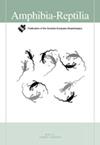Improving kettle holes as habitat and reproduction areas for amphibians – a case study in organic farms in north-eastern Germany
IF 1.3
4区 生物学
Q3 ZOOLOGY
引用次数: 0
Abstract
Kettle holes are found in young moraine landscapes and serve as an important habitat for amphibians. The loss of amphibians has been dramatic in recent decades, mainly because of the increase in land use intensity and deterioration of habitats e.g., kettle holes in agricultural landscapes. We monitored amphibian species on three organically managed farms in north-eastern Germany to get an overview of their occurrence and proof of reproduction to develop effective protection strategies. From 2016 to 2020, we investigated 50 kettle holes in cultivated fields. In 2018, we implemented the nature conservation measure ‘cutting back dense wooded belts’ in six of these kettle holes. Here, we focused on seven species considering four highly endangered species. We found six to seven species in up to 17 kettle holes in the 44 kettle holes without the measure ‘cutting back dense wooded belts’. Bombina bombina occurred at the most kettle holes (57%). The number of kettle holes where amphibians reproduced differed strongly. On average, at least one species reproduced at 58% of the kettle holes. Many kettle holes become overgrown with negative effects for amphibians due to the reduction in solar irradiation and higher water consumption. The nature conservation measure increased the number of species on average from two to four and the number of species with reproduction from one to three. It is one of more than 100 measures in the ‘Farming for Biodiversity’ project that farmers can choose to receive a nature conservation certificate, which can be used for marketing purposes.改善壶洞作为两栖动物的栖息地和繁殖地——德国东北部有机农场的案例研究
壶洞是在年轻的冰碛地貌中发现的,是两栖动物的重要栖息地。近几十年来,两栖动物的数量急剧减少,主要原因是土地利用强度的增加和栖息地(如农业景观中的壶洞)的恶化。我们对德国东北部三个有机管理农场的两栖动物物种进行了监测,以获得它们的发生概况和繁殖证据,以制定有效的保护策略。2016 - 2020年,对50个耕地水壶洞进行了调查。2018年,我们在其中6个壶穴实施了“砍伐密林带”的自然保护措施。在这里,我们关注的是7个物种,考虑到4个高度濒危的物种。在没有采取“砍伐茂密树木带”措施的情况下,我们在44个壶洞中的17个壶洞中发现了6至7种物种。爆炸病发生在大多数的壶洞(57%)。两栖动物繁殖的壶洞数量差异很大。平均而言,至少有一个物种在58%的壶洞中繁殖。由于太阳辐照的减少和水的消耗增加,许多水坑变得杂草丛生,对两栖动物产生负面影响。自然保护措施使平均物种数量从2个增加到4个,繁殖物种数量从1个增加到3个。这是“农业促进生物多样性”项目中100多项措施之一,农民可以选择获得自然保护证书,这可以用于营销目的。
本文章由计算机程序翻译,如有差异,请以英文原文为准。
求助全文
约1分钟内获得全文
求助全文
来源期刊

Amphibia-Reptilia
生物-动物学
CiteScore
3.10
自引率
6.20%
发文量
39
审稿时长
6-12 weeks
期刊介绍:
Amphibia-Reptilia is a leading European multi-disciplinary journal devoted to most of the aspects of herpetology: ecology, behaviour, evolution, conservation, physiology, morphology, paleontology, genetics, and systematics.
Amphibia-Reptilia publishes high quality original papers, short-notes, reviews, book reviews and news of the Societas Europaea Herpetologica (SEH). The Societas Europaea Herpteologica (SEH) website is located at: www.seh-herpetology.org.
 求助内容:
求助内容: 应助结果提醒方式:
应助结果提醒方式:


